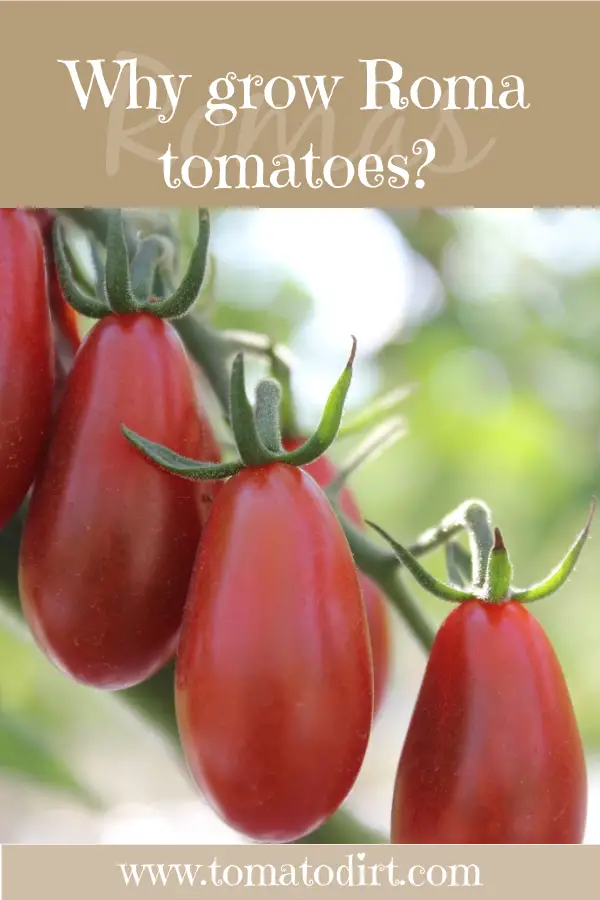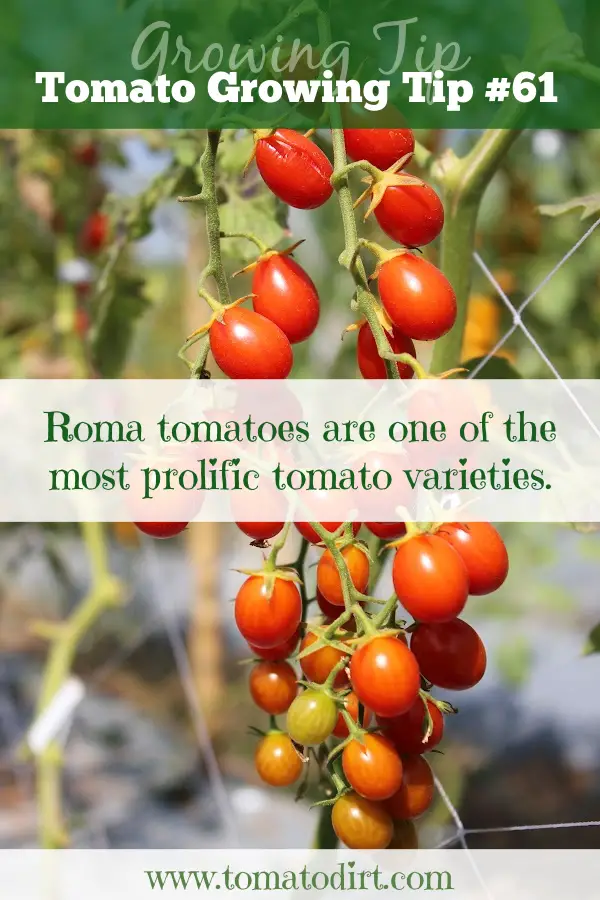FREE: 10 Must-Know Tomato Growing Tips Get The Guide
Read our affiliate disclosure here.
Get Saucy! Grow Roma Tomatoes
Since 2010, Tomato Dirt has garnered 4.8+ million views, making it the web’s leading online source for growing tomatoes in the home garden. Award-winning writer and Tomato Dirt owner Kathy Widenhouse has helped thousands of home gardeners grow healthier tomatoes. Be one of them when you get Tomato Dirt’s Growing Guide here.
Updated 1.5.25
Gardeners grow Roma tomatoes for canning, sauces, tomato paste, roasting, and drying.
And rightly so. Roma tomatoes are a type of plum tomato and as such have less water content and fewer seeds than Beefsteak or slicing tomatoes. They’re not juicy. Rather, a Roma’s thick flesh makes it good for cooking. And cooking intensifies their flavor.
The tomatoes themselves are egg-shaped or pear-shaped. They are smaller than a typical globe tomato but larger than a cherry or grape tomato and on average, about 3 inches long. Most Roma tomatoes are red, but some varieties are orange or yellow.
What is the origin of the Roma tomato?
As the United State agricultural industry and automation grew in the aftermath of World War II, so did the need for new tomato cultivars for food processing. The Roma tomato was one of them.
We have the Agricultural Research Service scientist William Porte to thank for the Roma, which was bred to resist diseases, pests, and grow well in different climates. In 1955, the breeder worked his magic at the USDA's Plant Industry Station, Beltsville, Maryland to come up with the Roma.
Some sources say Roma tomatoes are a cross of the Pan American tomato with San Marzano tomato. Others cite Red Top tomatoes as part of the original mix. Regardless, the new fruit variety became a commercial favorite.
Roma VF is even more disease resistant than the original. The strain, a cross between a Roma tomato and a California Red Top VR 9, was introduced in 1963 by the Joseph Harris Seed Company of Rochester, New York. Roma VF is especially resistant to verticillium wilt and fusarium wilt – hence the VF moniker. All that ability to ward off infection makes Roma VF a favorite for home gardeners.
It was a gene mutation – known in the genetic world as SUN (named after the Sun 1642 tomato variety) that gave the Roma its characteristic oblong shape.
Roma tomato varieties
Since the Roma tomato’s entry into the marketplace, more varieties have been introduced including:
- Granadero: a particularly prolific variety that is especially resistant to fusarium wilt, tomato mosaic virus, and verticillium wilt
- Heinz: one of the most popular Roma varieties, known for especially high levels of lycopene.
- Martino’s Roma: a semi-determinate tomato and one of the best Romas for sauce.
- Marzino F1: a mini Roma tomato that’s just 3 centimeters long and very sweet. Its taste and size make Marzinos a good snacking fruit.
- Old Ivory Egg: also called the Australian Yellow Plum, this light-yellow Roma tomato variety is shaped like (you guessed it) an egg. But watch your watering schedule … this fruit is particularly susceptible to cracking.
- Plum Regal: a hybrid, deep red Roma that offers good resistance to fusarium wilt, late blight, tomato spotted wilt virus, and verticillium wilt
- Striped Roman (Speckled Roman): a typical Roma but with unique, yellow stripes. Tomatoes can be 4-6 inches long.
- Sunrise Sauce: an easy-to-peel, orange Roma. Plants are bushy, making them especially good for containers.
- Ukrainian Purple: a deep plum-colored tomato originally cultivated in (where else?) Ukraine – and naturally cold tolerant.
(Browse Roma tomato seeds and plants.)
Plum tomato vs Roma tomato: what’s the difference?
The two terms are often used interchangeably, although they’re not the same thing.
A plum tomato is a type of tomato grown for sauce. It’s also called a paste tomato, Italian cooking tomato, or sauce tomato. The Roma tomato is one of many plum tomato varieties – in fact, it’s one of the most popular plum tomatoes grown by gardeners, along with San Marzano tomatoes and Amish Paste tomatoes.
As for commercial production, Roma VF tomatoes are one of the most common. That may explain why the terms “plum tomato” and “Roma tomato” are mistakenly swapped for each other.
What are Roma tomatoes good for?
Canning, tomato sauces, tomato paste. Roma tomatoes have a lower water content, fewer seeds, and firm, thick interiors, making them particularly suited for cooking down. And the lower water content and strong flesh means Roma tomatoes are among the top choice for drying, slow roasting, in salads, and for salsas. Romas also freeze well.
Nutrition in Roma tomatoes
Potassium, vitamin C, vitamin A, lutein, zeaxanthin, and lycopene: they’re nutrients are important for your vision, immunity, and may lower your risk of certain cancers. And Romas are packed with them. A single Roma tomato contains 11 calories and one gram of fiber.
Are Roma tomatoes heirlooms, open pollinated tomatoes, or hybrids?
It depends. The original Roma tomato was bred as a hybrid. But by now, decades later, Roma VF tomatoes are so stable that they’re considered to be open pollinated tomatoes – that is, a plant that is self-fertilized or fertilized by the same variety. (Heirlooms are OP tomatoes that have reproduced for generations. Hybrid tomatoes are a cross between two varieties.)
How to grow Roma tomatoes: FAQs
Roma tomatoes grow on compact, determinate vines. The following questions can help you understand and grow Roma tomatoes successfully.
Q. Are Roma tomatoes determinate or indeterminate?
Roma tomatoes are determinate – that is, they have a bush-like habit rather than a vine-like habit. The plant’s branch tips end in flower clusters, which then allows its fruit to develop roughly all at once. A determinate produces tomatoes for a few weeks and then production fades out.
This is good news for gardeners who grow Romas and other plum varieties. Since fruit ripens in large batches, you have a large harvest for canning, juice, and sauce.
Q. What’s a Roma tomato's size?
Plants can grow to 4 to 6 feet tall – but rarely 8 feet or more because plants are determinate. The fruit are larger than cherry tomatoes and grape tomatoes – each about 3 inches long and weighing in about 2 ounces.
Q. Can I grow Roma tomatoes from seed?
Yes. Start them indoors 6-8 weeks before you last frost date. You can also grow Roma tomatoes from seedlings that you purchase from your local nursery or from an online vendor, like Burpee.
Q. Can I grow Roma tomatoes in a pot?
Yes. In fact, as a determinate tomato, Romas don’t get as big as indeterminates – which makes them better suited for containers. That said, choose the largest pot possible to grow Roma tomatoes – at least 20 inches across and at least 12 inches deep, preferable bigger. Use a standard potting mix with plenty of organic matter, since tomatoes are heavy feeders. Roam tomato plants tend to be bushy, so install tomato cages or stakes when you plant them in containers so you don’t damage the root system later.
Q. Can I grow Roma tomatoes indoors?
Yes. As a bush variety, Roma tomatoes adapt well to indoor growing provided you give them enough light and warmth.
Q. How should I stake Roma tomatoes? Do Roma tomatoes need a trellis?
Staking determinate tomato plants can be considered optional because of their bushy habit. Plus, they produce fruit within a determined time span and then are finished. And of course, Romas are determinate. However, Roma tomatoes are among the biggest producers. You can support them with stakes, cages, or a trellis.
Q. Should I prune Roma tomatoes?
Prune if you like, but it’s not necessary. Plus, too much pruning can reduce the number of tomatoes on determinates since they have a limited growth cycle.
Q. How many Roma tomatoes can I get per plant?
You pick 10-20 pounds of tomatoes from the average tomato plant of any variety. Depending on the size of fruit, that translates to 20-90 tomatoes per plant. Determinates have a shorter growing season, yield less – an average 55-62 fruit from each tomato plant, according to a Cornell University study.
But Romas are big producers. A Roma tomato plant may yield up to 200 tomatoes in a growing season.
Q. How long does it take Roma tomatoes to ripen on the vine?
The typical Roma tomato ripens in 75-80 days after planting or 100-120 days after starting seeds.
Q. When should I pick Roma tomatoes?
If you go simply by feel, a Roma tomato can trick you into thinking it’s ready for harvesting. Even when it’s not yet ripe, its exterior is firmer to the touch than other tomatoes. The key is to check the entire tomato. When its color is uniformly red (or pink, orange, or yellow, depending upon the Roma variety), then it’s ready to pick.
More about understanding tomato varieties
What are the Easiest Tomatoes to Grow?
Determinate Tomatoes vs Indeterminate: What’s the Difference?
Heirloom Tomatoes vs. Hybrids -- what's the difference?
What are Open Pollinated Tomatoes? FAQs ...
All About Oxheart Tomatoes for the Home Gardener ...
What Are Beefsteak Tomatoes? FAQs ...
How to choose tomato varieties for your garden ...
Grafted tomatoes: what are they and why grow them?
Cherry Tomato FAQs: Find Out About These Tiny Tomato Favorites...
See more tomato varieties on our Pinterest board...
Return from Grow Roma Tomatoes to Tomato Dirt home
As an Amazon Associate and Rakuten Advertising affiliate I earn from qualifying purchases.
SHARE THIS PAGE:
FREE! 10 Must-Know Tomato Growing Tips: 20-page guide
Get yours here:





